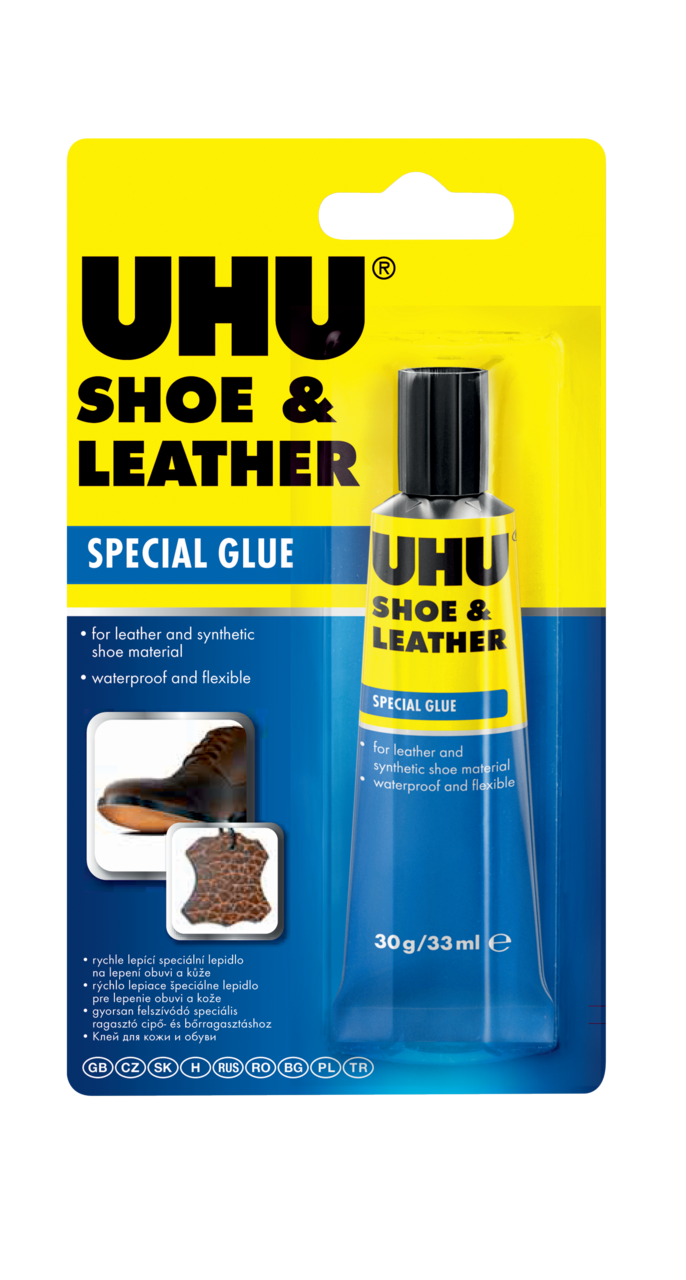UHU 46680 Shoe & Leather 30g/33ml

- Fast bonding and flexible repair adhesive
- For bonding leather and rubber, also in combination with other materials
- Bonding remains flexible: balance of material tension
- High water and temperature resistant
- Suitable for leather, rubber, flexible foam, fabrics, felt, cork. Ideal for repairing worn down soles, heels and holes in sides and upper parts of almost all kinds of shoes and boots - also for belts.
- Not suitable for Styrofoam®, soft PVC, polyethylene and polypropylene.
Directions for Usage:
- The surface must be dry, clean and free of dust and grease. Working conditions approx. +15°C and +30°C
- The contact method:
- Apply shoe & leather evenly to both of the parts to be stuck together using a toothed spatula or a short-bristled brush.
- Apply a number of times to very absorbent materials (leather, fabric, felt, etc) until a readily visible film of adhesive remains.
- Keep the parts separate until the layer of adhesive is dry to the touch (this takes 10-15 minutes, depending on the temperature).
- Then place the parts together in their exact position and press together very firmly for a short time. No adjustment can be made. The firmness of the assembly depends on the amount of pressure applied and not the amount of time the pressure is applied – a few seconds is sufficient. If the assembly has been put together properly, it may be worked on immediately.
- The heat reactivation method:
- This method is recommended when both of the parts to be stuck together require a very high degree of initial bonding. Using this method also makes the assembly more resistant to heat.
- Apply adhesive to both parts of the assembly, as for the contact method (see above).
- Leave until completely dry.
- At any time subsequently, the parts are placed together in their exact position and bonded by applying heat in the region of +120°C to +150°C (using a heat press, infra-red lamp or a hot air blower; for small parts a household iron may be used).
- When using this method, care must be taken that the requested temperature must advance up to the adhesive joints. When this method is used, no adjustment is possible. If the parts of the join are under tension (curves, overlays, etc.), the assembly should be maintained in place until it has cooled down to room temperature.
- The solvent reactivation method:
- This method is recommended if it is preferred to extend the working time beyond about 30 minutes, for example to prepare the parts, or to temporarily store them and take up the assembly again at a later period in time.
- The adhesive is applied to both sides of the assembly, as for the contact method (see above).
- Leave until completely dry. Assembly can then be carried out at any time subsequently; one of the surfaces is wiped over with a lint-free cloth dipped in solvent and the parts are immediately pressed together very firmly. Suitable solvents for reactivation include methyl ethyl ketone (MEK), butyl acetate or nitro thinners.
- Lower temperatures and high humidity increase the hardening time of the adhesive and, thus, make good adhesion more difficult
- Remaining adhesive can be removed and equipment cleaned using methyl ethyl ketone (MEK), ethyl acetate or nitro thinners.
- Store in tightly closed packaging in a dry, cool and frost-free place.
Caution:
- Dilution: if necessary the product can be diluted (nitro thinners and butyl acetate). Not more than 10% should be added, otherwise the adhesive properties of the product will be altered.
- Shoe & leather contains volatile, highly flammable solvents; precautions are therefore necessary during use and storage. Ensure proper ventilation when using over large areas.











